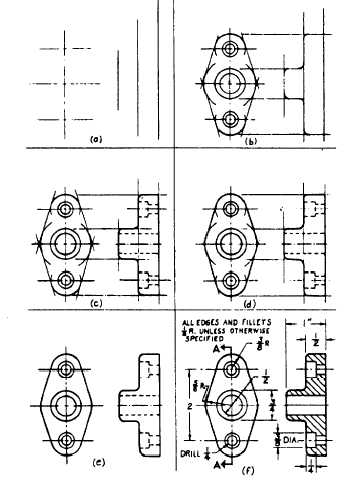45.161
Figure 3-40.-Order of penciling a drawing.
3. Draw the horizontal and vertical outlines,
visible lines, and hidden lines.
4. Draw the nonhorizontal and nonvertical
outlines, visible lines, and hidden lines.
5. Clean up the drawing, erasing all excess
lines and construction lines. A construction line
is a light line used as a drawing guide only.
6. Draw extension lines, dimension lines,
section lines, and any other lines required.
7. Inscribe the dimensions and lettering.
To a limited extent you can vary the thickness
of a pencil line by varying the extent to which you
bear down on the pencil. However, you can’t bear
down very hard without troughing the paper.
Therefore, you can’t get much variety in line
weight with a pencil. For a drawing that will be
inked over, this doesn’t make any difference.
However, for one that will not be reproduced, or
which will be reproduced directly from the pen-
cil original, you must follow, as nearly as you can,
the line conventions.
ORDER OF INKING
The beginner is usually frightened at the
prospect of trying to ink a drawing without
spoiling it. Once you have learned how to use
drawing instruments and to follow a definite order
of inking, you will have greatly reduced the danger
of spoiling a drawing. Nowadays, draftsmen
prefer the reservoir pen or rapidograph to the
ruling pen for inking straight and curved lines
and even for lettering. On the other hand, the
ruling pen should NEVER be used to ink freehand
lines.
One good way to avoid smeared ink lines is
by using SPACE BLOCKS. These strips of tape
or thin pieces of plastic, when fastened to both
faces of the triangles, french curves, or templates
(fig. 3-41), raise their edges from the surface of
the drafting paper and prevent ink from running
under the edge.
When you use a rapidograph or reservoir pen
with a T square or parallel straightedge, make
long lines with a whole arm movement and short
lines with a finger movement.
Draw horizontal lines from left to right,
starting at the top of the drawing and working
down. (If you are left-handed, you will, of course,
draw these lines from right to left, and similarly
reverse many of the directions given in this
training manual.)
Figure 3-41.-Use of space blocks.
3-27




